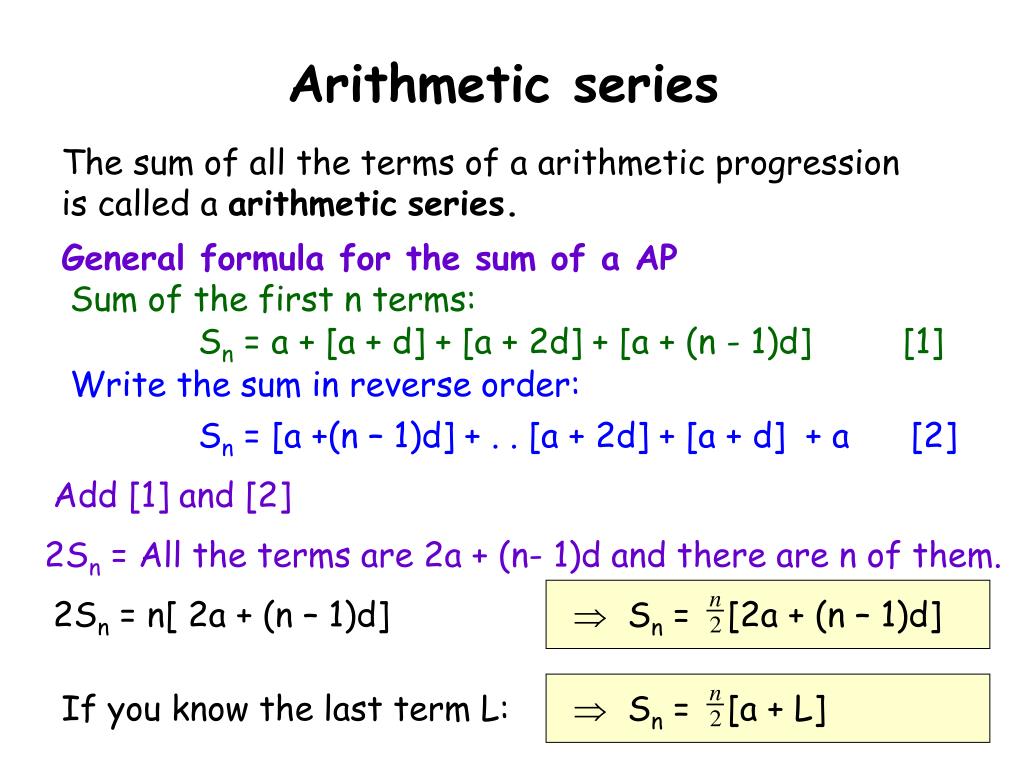
#Sum of arithmetic sequence code#
Step 1: The nth term of an arithmetic sequence,Īn = a1 + (n – 1)d, where the first term is a1, the second term is a1 + d, the third term is a1+ 2d, etc and this gives the formula of the sum of the arithmetic series, Sn Viewed 498 times -1 How do I make a code that follows this.
#Sum of arithmetic sequence series#
“n” is the total number of terms in the sequence andĭerivation of Sum of Arithmetic Series FormulaĮvery term following the first is derived by adding a constant, referred to as the common difference (d), in an arithmetic sequence. “d” is the common difference between the terms, “S” is the sum of the arithmetic sequence, When the Last Term is Not Given: S = n/2 When the Last Term is Given: S = n/2(a + L)

The following are the formulae for the sum of the arithmetic sequence: We can find the sum of the arithmetic series in one of two methods. We know that the addition of the members leads to an arithmetic series of finite arithmetic progress, which is given by (a, a + d, a + 2d, …) where “a” = the first term and “d” = the common difference.įormula for Sum of Arithmetic Sequence Formula The formula for calculating the total of all the terms in an arithmetic sequence is known as the sum of the arithmetic sequence formula. Arithmetic series is the sequence of numbers with common difference where the first term of a series is fixed which is ‘a’ and the common difference between them is ‘d’. C in Depth: The Complete C Programming Guide for Beginners. Solution : Increment of salary per year 1500 monthly increment 1500/12 125 write the expenses as a sequence 1st month expense 13000 increasing expenses per year 900 monthly increment of expenses 900/12 75 Let us write the monthly earnings and expenses as a sequence. What Is Sum of Arithmetic Sequence Formula? C++ Program for sum of arithmetic series. The general form of an A.P is: (a, a+d,a+2d,a+3d……) where a is the first term and d is a common difference. The nth term of an A.P is given by Tn= a+(n−1)d, where a is the first term, d is a common difference and n is the number of terms. While an infinite A.P does not have the last term, a finite A.P will. If the common difference of any two consecutive terms, for any A.P, is as follows:įinite and Infinite Arithmetic ProgressionĪ finite AP is an A.P in which the number of terms is finite.Īn infinite A.P is an A.P in which the number of terms is infinite. In the progression: 2, 5, 8, 11, 14 …the common difference is 3."Common difference"(d) is the difference between two consecutive terms in an AP (which is constant). Key Terms: Arithmetic Progression, Common Difference, Finite and Infinite AP, General Term, SumĪrithmetic progressions are progressions in which the difference between two consecutive terms is constant. Derivation of Sum of Arithmetic Series Formula.Formula for Sum of Arithmetic Sequence Formula.What Is Sum of Arithmetic Sequence Formula?.Finite and Infinite Arithmetic Progression.2008: David Nelson: The Penguin Dictionary of Mathematics (4th ed.) .(next): Entry: arithmetic progression (arithmetic sequence)

1998: David Nelson: The Penguin Dictionary of Mathematics (2nd ed.) .Knuth: The Art of Computer Programming: Volume 1: Fundamental Algorithms (3rd ed.) . Spiegel: Mathematical Handbook of Formulas and Tables . When we sum a finite number of terms in an arithmetic sequence, we get a finite arithmetic series. (next): $3.1.9$: Sum of Arithmetic Progression to $n$ Terms The first element is 10, and total elements are 100 (Total elements in the sequence 10, 20, 30, 1000 are 100). Stegun: Handbook of Mathematical Functions . This is an arithmetic sequence with common difference of 10. This is because the word is being used in its adjectival form.

In the context of an arithmetic sequence or arithmetic-geometric sequence, the word arithmetic is pronounced with the stress on the first and third syllables: a-rith- me-tic, rather than on the second syllable: a- rith-me-tic. Let $\sequence \)ĭoubt has recently been cast on the accuracy of the tale about how Carl Friedrich Gauss supposedly discovered this technique at the age of $8$.


 0 kommentar(er)
0 kommentar(er)
